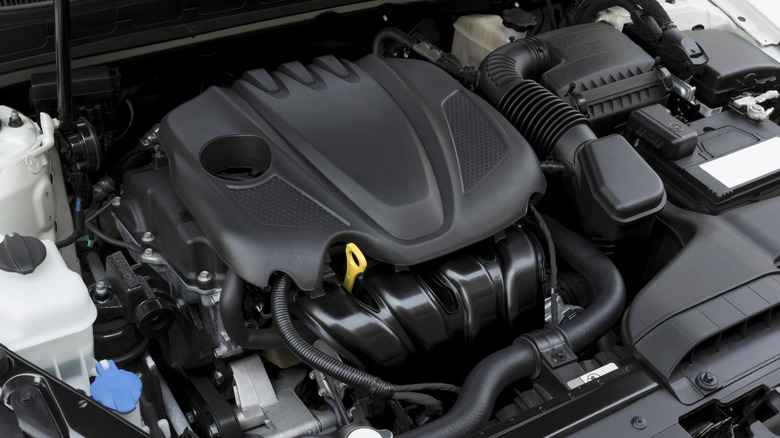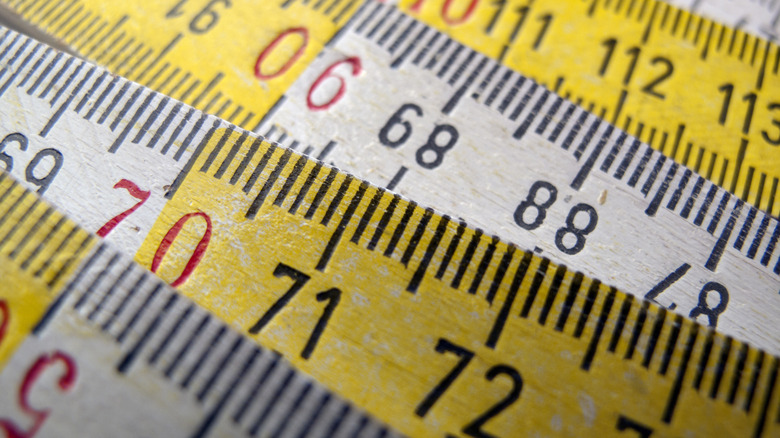Why Are Engines Measured In Liters? (And What The Numbers Indicate)
Those of us here in the United States are used to measuring various physical attributes with the imperial measurement system, which includes feet, inches, gallons, and so on. This system is still taught in schools, and sees use through many facets of daily life and business. While we've been using the imperial system for a long time, the other major measurement system, the metric system, has still managed to pop up in certain areas of American life.
For example, if you were talking about installing a new engine in a car and you were thinking exclusively in terms of imperial measurements, you'd be discussing cubic inches. However, for many engines, their size is actually measured in a metric scale, specifically the metric unit of volume, liters. This little disconnect from the rest of our measurement system can make discussing new engines a tad confusing, and the reason it even happens has a surprising amount of history behind it. Once you get what it all means, though, you'll find the numbers are fairly straightforward.
Measuring engines in liters became a marketing tool
The metric system of measurement was originally established in France in 1790, after which it swiftly swept all of Europe in a multinational effort to standardize measurement across cultures. At the time, the burgeoning United States was gradually piecing together its own system of measurement, but when word of the metric system came down the wire, the Founding Fathers weren't interested, so they stuck with the imperial system. In the decades that followed, multiple attempts were made to convince the U.S. to go metric, with varying levels of success.
Fast-forward to 1975, and Congress, along with President Gerald Ford, established the U.S. Metric Board to help the country gradually transition to the metric system. This full transition ultimately failed, but some elements of the private sector, particularly car manufacturers, saw an opportunity. While the U.S. wasn't interested in going metric, the system had definitively taken hold over most other first-world countries. This is why many car manufacturers with international dealings began offering their parts lists in metric terms for foreign buyers. The practice started to become commonplace following the signing of the Fair Packaging and Labeling Act in 1994.
So, to make a very long story short, the choice to use liters for engine measurement was a marketing decision. A tale as old as time, truly.
Engine liters indicate how much air its cylinders take in
So, what exactly does the number of liters tell you about an engine's capabilities? It's actually very simple: an engine's liter measurement indicates the total internal volume of all its cylinders. Remember, the operation of a combustion engine is reliant on drawing oxygen in from outside the engine, mixing it with fuel, and then firing it off within the cylinders. Naturally, a larger big-block engine with bigger, more numerous cylinders would be able to draw in more oxygen at once, which means it can consume more fuel to generate more power.
Through a lengthy equation based on the number of cylinders in your engine, as well as each cylinder's bore (diameter) and the length of the piston's stroke inside each cylinder, you can determine the engine's total volume, or displacement, in cubic centimeters, or cc. The cc rating is then translated to liters at a ratio of 1,000 to 1, usually rounded for simplicity's sake. For example, if you had an engine measuring in at 2,139cc, that would mean the engine is about 2.1L. Incidentally, one liter equals about 61 cubic inches, so you could still keep it imperial if you really wanted to, though it might make your engine seem more impressive than it actually is.


